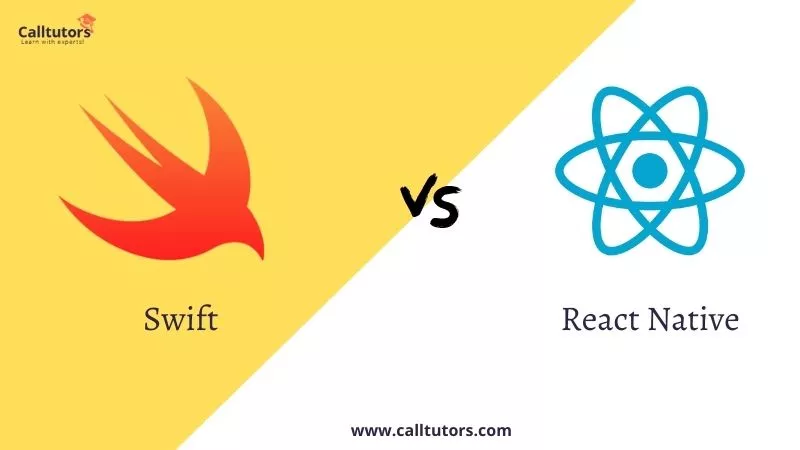Do you want to create an iOS app, then there are so many options of languages are available to choose from. And from those, the languages that are most popular ones are Swift and React Native.
And today in this blog, we are going to compare the Swift vs React Native and with this comparison, you will get a clear idea about both Swift vs React. Before going deeper, Let’s start with a short introduction to each of these terms.
What is React Native?
Table of Contents
Facebook created and supported React Native, an open-source framework for cross-platform mobile apps. With a single javascript codebase, you can develop native apps for the iOS as well as for the Android platforms. And for creating the native mobile app accurately, it uses the React.js library. On GitHub, it has 78.3K GitHub stars and 17.5K forks.
What is Swift?
Swift is the official framework, and Apple created it. It’s used to make native apps for Apple’s iOS devices, which include iPhones, Apple computers, Apple Watches, and Apple TVs. Swift uses the Cocoa and Cocoa Touch frameworks from Apple.
It’s the ideal choice to create the projects that require complicated infrastructure, integrations, and native iOS capabilities like in-app payment. It has 48.2K GitHub stars and 7.71K GitHub.
Swift vs React Native: The Key Differences
1. User Interface
Swift is a native language for designing strong IOS applications, thus it seamlessly interacts with the IOS designs and takes use of all UX aspects.
Simultaneously, the development team must build a native app from scratch and polish each app design element independently to make a mobile app on Swift.
In contrast, React Native is driven by JavaScript and uses internal APIs to execute native components that adapt to any screen size. The native interface has the same user interface and is considerably easier to develop.
Furthermore, all of the app’s elements will be presented correctly across various screen sizes, including iPhone, iPad, and other mobile devices.
2. Speed of coding
Swift is viewed as one of the most time-efficient ways of developing an iOS application. It eliminates the Objective C drawbacks and makes application creation easier.
In contrast, React Native is an excellent alternative if you want to develop an app for both Android and iOS at the same time.
3. Community and Support
Swift programmers may get help from other programmers in a public forum. In contrast, React Native is an open-source framework that receives contributions from corporations and individuals all around the world.
4. Performance
In order to determine which framework is optimal for mobile apps, performance is one of the most important things. The three most important parameters for various tasks are CPU utilisation, allotted memory, and energy impact.
Native mobile applications written in Swift use all of the possibilities of the device, particularly graphic effects and computationally intensive activities.
When creating a mobile application with the help of React Native, developers construct modules to use internal APIs and libraries on their own. There is a considerable risk of affecting the performance of the apps because there is a middleman between the code and the platform.
5. Community
JavaScript is one of the most popular programming languages today and has a vast community. React Native, which is based on JavaScript, has a great fan and user following. The Supervisory Board uses a variety of channels for exchanging information or knowledge and for supporting sharing. However, this can occasionally result in overly ambiguous and messy answers to issues, yet it is still quite involved.
The community of Swift is a smaller one than the RN due to programming only for Apple systems. However, this is a group of people who are dedicated ones. Furthermore, the Swift issues are related to the development of the iOS app only. Hence, they’re more focused, and assuming you’re not seeking a solution to some exceedingly complex problem that has never been encountered before, finding a solution or assistance in the community may be a lot simpler.
Swift vs React Native: In Tabular Form
| Parameters | Swift | React Native |
| Stability | It is more stable | It is less stable |
| Performance | Good performance | Poor performance as compared to Swift |
| User Interface | Native | More like native |
| Development Cost | High | Relatively Low |
| Popularity | Average | Very Popular |
| Cross-Platform | No | Yes |
| Learning Curve | Average | Easy |
| Native Development | Yes | No (it uses internal APIs & Libraries) |
| Programming Language | Swift | JavaScript |
| Speed of Coding | Very fast for iOS applications | For Android & iOS, faster to code but slower for alone iOS |
| Popular Apps | WhatsApp SlackLinkedIn | WalmartBloomberg Facebook |
Swift vs React Native: Use Cases
| React Native | Swift |
Swift vs React Native: Pros and Cons
Pros And Cons Of Swift
| Pros | Cons |
Pros And Cons Of React Native
| Pros | Cons |
Conclusion: Swift vs React Native
In this blog, we have discussed Swift vs React Native. Both Swift, as well as React Native, are great technologies and they are used for building the applications of mobiles. If you want to build an app with fewer resources & time availability then you should choose React Native framework. And if you want to build a complex iOS-only app that uses platform-specific code then you should choose Swift. Moreover, if you need any Javascript assignment help, we are 24X7 available to help you.
FAQs Related To Swift vs React Native
Is Swift good for beginners?
Swift comes with excellent documentation and one more thing that it is simple or we can say that it is easy to learn for beginners. Swift is the perfect option for you if you enjoy creating amazing visual content.
Should I learn React Native or Swift?
No other language performs better than Swift when it comes to developing mobile applications, especially for the iOS operating system. If you want to create cross-platform mobile apps, however, you should use React Native.




